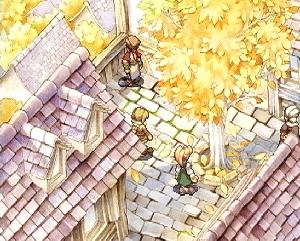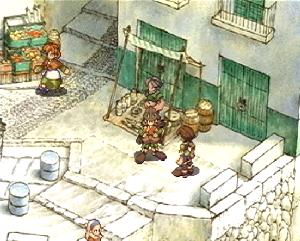Saga. The final frontier. These are the voyages of… Gustav XIII?
History tells the story of winners. Whoever wins the wars gets to put their
name in the textbooks, write the story of the conflict (their version), and
create a legacy for themselves. Of course, if it’s just in a boring-ass textbook,
most people won’t ever give a damn, and that’s Saga Frontier II in a
nutshell.
Gustav
XIII was born into royalty; living the life of affluence, he never knew what
it was like to suffer… until he was cast out from the Kingdom when it was discovered
he did not have the power to control the Special Arts. Shunned by the world,
Gustav vows to fend for himself and prove that the heights to which one can
succeed are not decided by destiny or genetics, but by the strength of the human
spirit. Kind of like a medieval Gattaca. The second character, Wil Knights,
is in search of treasure. He seeks a mystical Egg that he believes holds the
answers to the deaths of his parents. How far will Gustav and Wil go, and how
much will they sacrifice to fulfill their goals?
The game reads like your run of the mill history book. From age to age, cradle
to grave, and scenario-to-scenario, you are given glimpses into the lives of
these two men. Yet that’s just it: Glimpses. The progression of the game is
from one short story to the next, separated by save points. There is no true
interweaving strand that binds the story you and makes you want to follow the
lives of Wil and Gustav. Instead, dates and events are just plugged together.
History becomes interesting when you are drawn to the characters that create
it; so too it might have been with this game.
Most of the rest of the story comes from talking to the other people in town.
The villagers are, well, idiots. They are filled with boring and uninteresting
comments, lacking all personality. You’ll be forced to talk to these morons,
walking from person to person in order to trigger the next event and set the
game in motion once more. At least in the RPG Grandia,
going from person to person is interesting and fun — hearing another story
or minor oddity from one of the townspeople is actually worth the time. Outside
of town, you get to fight.
There are two fighting systems within the game: group battle and one on one
(combo). Sometimes you pick the method. Other times, the game picks for you.
Enemies are visible and avoidable. Group battle pits your party against a set
of enemy of opponents. Joint attacks are triggered when two members of the group
select the correct corresponding moves. When you fight one on one, you select
a sequence of four moves, and then watch the results. The correct combinations
yield stronger and more efficient attacks.
 The
The
best fighting systems are initially simple and easy to learn, but upon deeper
inspection, they reveal layers of depth. Saga Frontier II reverses this
theory, by seeming complex at first, but then underneath it’s lacking. While
it is decidedly different, it doesn’t have that tweaked refinement that makes
a fighting system memorable.
Graphically, the game succeeds brilliantly. The entire style is like a painted
water-color storybook, filled with artistic detail. There are brilliant details
like a flickering fire that casts shadows against a charcoal gray night, or
a cobblestone floor with a rain-soaked glow. It’s a welcome change of pace from
the polygonal rendered norms. During the battle scenes, however, the backgrounds
are polygonal with mixed results. Sometimes it looks awkward and short on detail,
but there are also times when they successfully match the painted look.
The characters themselves are big sprites set against the backgrounds. While
impressively large, they would have benefited from more frames of animation.
It would have also been worthwhile to see the character art done in a way other
than the all-too-common anime/super deformed look. What about the concept art
all over the instruction manual?
Musically, it leans towards the gentle simplicity of the piano. Melodic and
flowing, it has a unique charm and quietness, a sharp contrast to the generally
more charged Final Fantasy tunes. The score fits the mood and atmosphere
perfectly. However, once again, this is a Square game and it lacks the ever-important
voice-overs. C’mon Square — get with the times.
This game does have its moments of beauty and interest, but the binding that’s
supposed to hold these individual elements together isn’t strong enough. The
story simply fails to engage the player like it should. Saga Frontier II
simply wasn’t written in a way that pulls you into the game. Despite the pretty
pictures, this is one history book that ultimately falls apart.

-
Beautiful storybook graphics
-
Fair fighting system
-
Average story, poorly told
-
Lack of voices
-
Not well bound together







